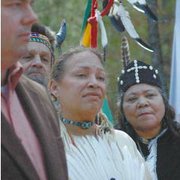By Charlie Passut | Tidewater News
Published Saturday, March 21, 2009

COURTLAND—For the first time in centuries, the Cheroenhaka (Nottoway) Indian Tribe has its land back.
On Friday, the tribe’s foundation officially purchased 100 acres from Sustainable Forest LLC, a Delaware limited liability company and an arm of International Paper Co.
Several dozen members of the tribe were on hand and in full regalia to witness the historic event, officially called a “land closing peace pipe ceremony.”
“This will be a historic moment in the history of the tribe,” Chief Walt “Red Hawk” Brown said. “It is a Creator-sent blessing that in the 21st century we are reclaiming a small portion of the reservation land that once belonged to our tribe. With ownership of the land, we can now work toward bringing our goals to fruition.”

Bernard “Fire Walker” Hedgepeth (background, from left), Vashti “Sparrow Hawk” Clark and Lila “Spirit Heart” Hedgepeth listen to Chief Walt “Red Hawk” Brown’s comments during Friday’s “Land Closing Peace Pipe Ceremony,” while Mark Remaley of International Paper Co. looks on.
The 100-acre parcel is located on Old Bridge Road, just south of Courtland. The land is a wooded area, and according to a survey map the southern boundary of the parcel is near, but does not quite reach, the Nottoway River.
“This is a very proud moment for all of us at International Paper,” said Mark Remaley, a fiber manager for the company in Courtland. “For many years this has been a working forest. And (like) the working forests that we have managed for many years, this forest went through a rebirth many times. We would harvest the trees, and then plant them back, so that we would have a future forest for generations to come.”
And then came the moment that the tribe had been waiting for seven years.
“So today, I hand Mr. Brown the purchase and sales agreement to move this land from International Paper’s stewardship to the Cheroenhaka (Nottoway) Indian stewardship for generations to come.”
Since re-forming in February 2002, one of the tribe’s goals has been to acquire a portion of their former reservation land either through purchase or donation.
According to information from the tribe, about 41,000 acres were given to the tribe as a reservation in 1705 by the House of Burgesses, which was then the colonial government of Virginia. The reservation was divided into two parts, the Circle Tract and the Square Tract, which were 18,000 and 23,000 acres in size, respectively.
The reservation started to disappear in 1735 after land grabs by colonists. By 1877, the final 525 acres of the reservation were divided among surviving tribal members.
Brown said the 100-acre tract purchased by the tribe Friday was once part of the Square Tract.
The tribe plans to construct a tribal cultural center and museum on the property, as well as powwow grounds and a worship center. Brown said the tribe would also develop an interactive Native American village called Cattashowrock Town.
According to Brown, Cattashowrock Town was the name of one of three Cheroenhaka (Nottoway) villages known to colonist James Thweatt, who stated that he knew of the villages’ existence for 48 years in a sworn affidavit in November 1707. Thweatt also stated that the Cheroenhaka (Nottoway) Indians called the nearby river “Nottoway.”
Cattashowrock Town would be constructed as a replica of a 1580s Iroquoian village, complete with a palisade and Iroquois traditional “long houses,” similar to the ones discovered in the 1960s in Southampton County near General Thomas Highway.
“In the long term, we envision some 40 to 50 thousand tourists per year visiting the area,” Brown said. “We are trusting that the local communities will take a proactive role and interest in the goals of the tribe and lend their support monetarily or in kind.”
Meanwhile, a bill seeking federal recognition of six Virginia tribes went before the House Committee on Natural Resources on Wednesday.
The Thomasina E. Jordan Indian Tribes of Virginia Federal Recognition Act of 2009 seeks recognition of the Chickahominy Indian Tribe, the Chickahominy Indian Tribe-Eastern Division, the Upper Mattaponi Tribe, the Rappahannock Tribe, Inc., the Monacan Indian Nation, and the Nansemond Indian Tribe.
The federal government currently recognizes 562 tribes in the United States.
According to Chief Stephen R. Adkins of the Chickahominy Indian Tribe, the law would guarantee access to archaeological sites on public land, the ability to retrieve the bones of ancestors from federal repositories, and create a formal relationship between the tribes and the federal government.

